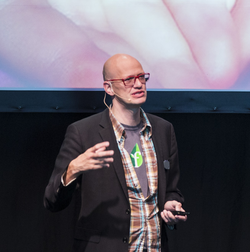Entrepreneurship

Entrepreneurship
Entrepreneurship is the process of designing, launching, and running a new business which is often initially a small business. The people who create these businesses are called entrepreneurs. [33] [24] Entrepreneurship has been described as the "capacity and willingness to develop, organize and manage a business venture along with any of its risks in order to make a profit." [41] While definitions of entrepreneurship typically focus on the launching and running of businesses, due to the high risks involved in launching a start-up, a significant proportion of businesses have to close, due to "lack of funding, bad business decisions, an economic crisis, lack of market demand – or a combination of all of these. [44] In the 2000s, the definition of "entrepreneurship" expanded to explain how and why some individuals (or teams) identify opportunities, evaluate them as viable and then decide to exploit them, whereas others do not and, in turn, how entrepreneurs use these opportunities to develop new products or services, launch new firms or even new industries and create wealth. The entrepreneurial process is fundamentally uncertain because opportunities cannot be discovered or identified prior to their actualization into profits. What appears as a real opportunity ex-ante might actually be a non-opportunity or one that cannot be actualized by entrepreneurs lacking the necessary business skills, financial or social capital.
An entrepreneur has been defined as, "a person who starts, organizes and manages any enterprise, especially a business, usually with considerable initiative and risk; running a small business with all the risk and reward of any given business process." [58] [59] Entrepreneurs tend to be good at perceiving new business opportunities and they often exhibit positive biases in their perception (i.e., a bias towards finding new possibilities and seeing unmet market needs) and a pro-risk-taking attitude that makes them more likely to exploit the opportunity. [64] [33] An entrepreneur may be in control of a commercial undertaking, directing the factors of production – the human, financial and material resources – that are required to exploit a business opportunity. Entrepreneurs act as managers and oversee the launch and growth of an enterprise. Entrepreneurship is the process by which either an individual or a team identifies a business opportunity and acquires and deploys the necessary resources required for its exploitation. The exploitation of entrepreneurial opportunities may include: [33]
developing a business plan
hiring the human resources
acquiring financial and material resources
providing leadership
being responsible for both the venture's success or failure
risk aversion
The Economist Joseph Schumpeter (1883–1950) saw the role of the entrepreneur in the economy as "creative destruction" – launching innovations that simultaneously destroy old industries while ushering in new industries and approaches. For Schumpeter, the changes and "dynamic disequilibrium brought on by the innovating entrepreneur [were] the norm of a healthy economy." [33]
While entrepreneurship is often associated with new, small, for-profit start-ups, entrepreneurial behavior can be seen in small-, medium- and large-sized firms, new and established firms and in for-profit and not-for-profit organizations, including voluntary-sector groups, charitable organizations and government. [33]
Entrepreneurship may operate within an entrepreneurship ecosystem which often includes:
government programs and services that promote entrepreneurship and support entrepreneurs and start-ups
non-governmental organizations such as small-business associations and organizations that offer advice and mentoring to entrepreneurs (e.g., through entrepreneurship centers or websites)
small-business advocacy organizations that lobby governments for increased support for entrepreneurship programs and more small business-friendly laws and regulations
entrepreneurship resources and facilities (e.g., business incubators and seed accelerators)
entrepreneurship education and training programs offered by schools, colleges and universities
financing (e.g., bank loans, venture capital financing, angel investing and government and private foundation grants) [80]
History
Historical usage
Entrepreneur ( /ˌɒntrəprəˈnɜːr/ ( ) ), is a loanword from French. First used in 1723, today the term implies qualities of leadership, initiative, and innovation in new venture design. Especially in Britain, the term "adventurer" was often used to denote the same meaning. [33] Economist Robert Reich has called team-building, leadership, and management ability essential qualities for the entrepreneur. [137] [33] Historically the study of entrepreneurship reaches back to the work in the late 17th and early 18th centuries of Richard Cantillon, which was foundational to classical economics.
20th century
In the 20th century, entrepreneurship was studied by Joseph Schumpeter in the 1930s and other Austrian economists such as Carl Menger, Ludwig von Mises and Friedrich von Hayek. The term "entrepreneurship" was coined around the 1920s, while the loan from French of the word entrepreneur dates to the 1850s. According to Schumpeter, an entrepreneur is willing and able to convert a new idea or invention into a successful innovation. Entrepreneurship employs what Schumpeter called "the gale of creative destruction" to replace in whole or in part inferior offerings across markets and industries, simultaneously creating new products and new business models. Thus, creative destruction is largely responsible for long-term economic growth. The idea that entrepreneurship leads to economic growth is an interpretation of the residual in endogenous growth theory and as such continues to be debated in academic economics. An alternate description by Israel Kirzner suggests that the majority of innovations may be incremental improvements such as the replacement of paper with plastic in the construction of a drinking straw that require no special qualities.
For Schumpeter, entrepreneurship resulted in new industries and in new combinations of currently existing inputs.
Schumpeter's initial example of this was the combination of a steam engine and then current wagon making technologies to produce the horseless carriage.
In this case, the innovation, the car, was transformational but did not require the development of dramatic new technology.
It did not immediately replace the horse-drawn carriage, but in time, incremental improvements reduced the cost and improved the technology, leading to the modern auto industry.
Despite Schumpeter's early 20th-century contributions, the traditional microeconomic theory did not formally consider the entrepreneur in its theoretical frameworks (instead of assuming that resources would find each other through a price system). In this treatment, the entrepreneur was an implied but unspecified actor, consistent with the concept of the entrepreneur being the agent of x-efficiency.
For Schumpeter, the entrepreneur did not bear risk: the capitalist did.
Schumpeter believed that the equilibrium was imperfect.
Schumpeter (1934) demonstrated that the changing environment continuously provides new information about the optimum allocation of resources to enhance profitability.
Some individuals acquire the new information before others and recombine the resources to gain an entrepreneurial profit.
Schumpeter was of the opinion that entrepreneurs shift the Production Possibility Curve to a higher level using innovations.
Initially, economists made the first attempt to study the entrepreneurship concept in depth.
Richard Cantillon (1680–1734) considered the entrepreneur to be a risk taker who deliberately allocates resources to exploit opportunities in order to maximize the financial return. Cantillon emphasized the willingness of the entrepreneur to assume the risk and to deal with uncertainty. Thus, he draws attention to the function of the entrepreneur and distinguishes clearly between the function of the entrepreneur and the owner who provides the money. Alfred Marshall viewed the entrepreneur as a multi-tasking capitalist. He observed that in the equilibrium of a completely competitive market, there was no spot for "entrepreneurs" as an economic activity creator.
Historical barriers
Dating back to the time of the medieval guilds in Germany, a craftsperson required special permission to operate as an entrepreneur was the small proof of competence (Kleiner Befähigungsnachweis), which restricted training of apprentices to craftspeople who held a Meister certificate. This institution was introduced in 1908 after a period of so-called freedom of trade (Gewerbefreiheit, introduced in 1871) in the German Reich. However, proof of competence was not required to start a business. In 1935 and in 1953, greater proof of competence was reintroduced (Großer Befähigungsnachweis Kuhlenbeck), which required craftspeople to obtain a Meister apprentice-training certificate before being permitted to set up a new business.
Millennial entrepreneurs
The term "millennial entrepreneur" refers to a business owner who is affiliated with the generation that was brought up using digital technology and mass media; the products of Baby Boomers, those people born during the 1980s and early 1990s. Also known as Generation y, these business owners are well equipped with knowledge of technology and have a strong grasp of its applications toward businesses. There have been many breakthrough businesses that have come from millennial entrepreneurs such as Mark Zuckerberg, who created Facebook. [117] [11] Despite the expectation of millennial success, there have been recent studies that have proven this to not be the case. The comparison between millennials who are self-employed and those who are not self-employed shows that the latter is higher. The reason for this is because they have grown up in a different generation and attitude than their elders. Some of the barriers to entry for entrepreneurs are the economy, debt from schooling, and the challenges of regulatory compliance. [54]
2000s
In the 2000s, entrepreneurship has been extended from its origins in for-profit businesses to include social entrepreneurship, in which business goals are sought alongside social, environmental or humanitarian goals and even the concept of the political entrepreneur. Entrepreneurship within an existing firm or large organization has been referred to as intrapreneurship and may include corporate ventures where large entities "spin-off" subsidiary organizations.
Entrepreneurs are leaders willing to take risk and exercise initiative, taking advantage of market opportunities by planning, organizing, and deploying resources, often by innovating to create new or improving existing products or services.
[98] In the 2000s, the term "entrepreneurship" has been extended to include a specific mindset (see also entrepreneurial mindset) resulting in entrepreneurial initiatives, e.g. in the form of social entrepreneurship, political entrepreneurship, or knowledge entrepreneurship.
According to Paul Reynolds, founder of the Global Entrepreneurship Monitor, "by the time they reach their retirement years, half of all working men in the United States probably have a period of self-employment of one or more years; one in four may have engaged in self-employment for six or more years. Participating in a new business creation is a common activity among U.S. workers over the course of their careers." In recent years, entrepreneurship has been claimed as a major driver of economic growth in both the United States and Western Europe.
Entrepreneurial activities differ substantially depending on the type of organization and creativity involved.
Entrepreneurship ranges in scale from solo, part-time projects to large-scale undertakings that involve a team and which may create many jobs.
Many "high value" entrepreneurial ventures seek venture capital or angel funding (seed money) in order to raise capital for building and expanding the business. Many organizations exist to support would-be entrepreneurs, including specialized government agencies, business incubators (which may be for-profit, non-profit, or operated by a college or university), science parks, and Non-governmental organizations, which include a range of organizations including not-for-profits, charities, foundations and business advocacy groups (e.g., Chambers of Commerce). Beginning in 2008, an annual "Global Entrepreneurship Week" event aimed at "exposing people to the benefits of entrepreneurship" and getting them to "participate in entrepreneurial-related activities" was launched.
Definition
The term "entrepreneur" is defined as an individual who organizes or operates a business or businesses.
Credit for coining this term generally goes to the French economist Jean-Baptiste Say. However, the Irish-French economist Richard Cantillon defined the term first in his Essai sur la Nature du Commerce en Général, or Essay on the Nature of Trade in General, a book William Stanley Jevons considered the "cradle of political economy." Cantillon used the term differently; biographer Anthony Breer noted that Cantillon saw the entrepreneur as a risk-taker while Say considered the entrepreneur a "planner." Cantillon defined the term as a person who pays a certain price for a product and resells it at an uncertain price: "making decisions about obtaining and using the resources while consequently admitting the risk of enterprise." The word first appeared in the French dictionary entitled "Dictionnaire Universel de Commerce" compiled by Jacques des Bruslons and published in 1723. [105][142]
Relationship between small business and entrepreneurship
The term "entrepreneur" is often conflated with the term "small business" or used interchangeably with this term. While most entrepreneurial ventures start out as a small business, not all small businesses are entrepreneurial in the strict sense of the term. Many small businesses are sole proprietor operations consisting solely of the owner, or they have a small number of employees, and many of these small businesses offer an existing product, process or service, and they do not aim at growth. In contrast, entrepreneurial ventures offer an innovative product, process or service, and the entrepreneur typically aims to scale up the company by adding employees, seeking international sales, and so on, a process which is financed by venture capital and angel investments. Successful entrepreneurs have the ability to lead a business in a positive direction by proper planning, to adapt to changing environments and understand their own strengths and weakness. [109]
Ethnic entrepreneurship
The term "ethnic entrepreneurship" refers to self-employed, business owners who belong to racial or ethnic minority groups in the United States and Europe. A long tradition of academic research explores the experiences and strategies of ethnic entrepreneurs as they strive to integrate economically into mainstream US or European society. Classic cases include Jewish merchants and tradespeople in large U.S. cities in the 19th and early 20th centuries as well as Chinese and Japanese small business owners (restaurants, farmers, shop clerks) on the West Coast. [110]
In the 2010s, ethnic entrepreneurship has been studied in the case of Cuban business owners in Miami, Indian motel owners of the U.S. and Chinese business owners in Chinatowns across the United States. While entrepreneurship offers these groups many opportunities for economic advancement, self-employment, and business ownership in the United States remain unevenly distributed along racial/ethnic lines. [111] Despite numerous success stories of Asian entrepreneurs, a recent statistical analysis of U.S. census data shows that whites are more likely than Asians, African-Americans, and Latinos to be self-employed in high prestige, lucrative industries. [111]
Institutional entrepreneur
The USA-born British economist Edith Penrose has highlighted the collective nature of entrepreneurship. She mentions that in modern organizations, human resources need to be combined in order to better capture and create business opportunities. [44] The sociologist Paul DiMaggio (1988:14) has expanded this view to say that "new institutions arise when organized actors with sufficient resources [institutional entrepreneurs] see in them an opportunity to realize interests that they value highly." [44] The notion has been widely applied. [44] [44] [44] [44]
Feminist entrepreneur
A feminist entrepreneur is an individual who applies feminist values and approaches through entrepreneurship, with the goal of improving the quality of life and wellbeing of girls and women. [44] Many are doing so by creating ‘for women, by women’ enterprises.’ Feminist entrepreneurs are motivated to enter commercial markets by desire to create wealth and social change, based on the ethics of cooperation, equality, and mutual respect. [44] [44]
Entrepreneurial behaviors

In 2012, Ambassador-at-Large for Global Women's Issues Melanne Verveer greets participants in an African Women's Entrepreneurship Program at the State Department in Washington, D.C.
The entrepreneur is commonly seen as an innovator — a designer of new ideas and business processes.
Management skills and strong team building abilities are often perceived as essential leadership attributes for successful entrepreneurs.
Political economist Robert Reich considers leadership, management ability, and team-building to be essential qualities of an entrepreneur.
Uncertainty perception and risk-taking

British entrepreneur Karren Brady has an estimated net worth of $123 million [126]
Theorists Frank Knight and Peter Drucker defined entrepreneurship in terms of risk-taking. The entrepreneur is willing to put his or her career and financial security on the line and take risks in the name of an idea, spending time as well as capital on an uncertain venture. However, entrepreneurs often do not believe that they have taken an enormous amount of risks because they do not perceive the level of uncertainty to be as high as other people do. Knight classified three types of uncertainty:
Risk, which is measurable statistically (such as the probability of drawing a red color ball from a jar containing 5 red balls and 5 white balls)
Ambiguity, which is hard to measure statistically (such as the probability of drawing a red ball from a jar containing 5 red balls but an unknown number of white balls)
True uncertainty or Knightian uncertainty, which is impossible to estimate or predict statistically (such as the probability of drawing a red ball from a jar whose contents are entirely unknown)
Entrepreneurship is often associated with true uncertainty, particularly when it involves the creation of a novel good or service, for a market that did not previously exist, rather than when a venture creates an incremental improvement to an existing product or service.
A 2014 study at ETH Zürich found that compared with typical managers, entrepreneurs showed higher decision-making efficiency, and a stronger activation in regions of frontopolar cortex (FPC) previously associated with explorative choice.
"Coachability" and advice taking
The ability of entrepreneurs to work closely with and take advice from early investors and other partners (i.e., their coachability) has long been considered a critical factor in entrepreneurial success. [22] At the same time, economists have argued that entrepreneurs should not simply act on all advice given to them, even when that advice comes from well-informed sources, because entrepreneurs possess far deeper and richer local knowledge about their own firm than any outsider. Indeed, measures of coachability are not actually predictive of entrepreneurial success (e.g., measured as success in subsequent funding rounds, acquisitions, pivots, and firm survival). This research also shows that older and larger founding teams, presumably those with more subject expertise, are less coachable than younger and smaller founding teams.
Strategies
Strategies that entrepreneurs may use include:
Designing individual/opportunity nexus
According to Shane and Venkataraman, entrepreneurship comprises both "enterprising individuals" and "entrepreneurial opportunities," so researchers should study the nature of the individuals who identify opportunities when others do not, the opportunities themselves and the nexus between individuals and opportunities.
On the other hand, Reynolds et al. argue that individuals are motivated to engage in entrepreneurial endeavors driven mainly by necessity or opportunity, that is, individuals pursue entrepreneurship primarily owing to survival needs, or because they identify business opportunities that satisfy their need for achievement.
For example, higher economic inequality tends to increase entrepreneurship rates at the individual level, suggesting that most entrepreneurial behavior is based on necessity rather than opportunity.
Opportunity perception and biases
The ability of entrepreneurs to innovate relates to innate traits, including extroversion and a proclivity for risk-taking. According to Joseph Schumpeter, the capabilities of innovating, introducing new technologies, increasing efficiency and productivity, or generating new products or services, are characteristic qualities of entrepreneurs. [138] One study has found that certain genes affecting personality may influence the income of self-employed people. Some people may be able to use "an innate ability" or quasi-statistical sense to gauge public opinion and market demand for new products or services. Entrepreneurs tend to have the ability to see unmet market needs and underserved markets. While some entrepreneurs assume they can sense and figure out what others are thinking, the mass media plays a crucial role in shaping views and demand. Ramoglou argues that entrepreneurs are not that distinctive and that it is essentially poor conceptualizations of "non-entrepreneurs" that maintain laudatory portraits of "entrepreneurs" as exceptional innovators or leaders Entrepreneurs are often overconfident, exhibit illusion of control, when they are opening/expanding business or new products/services. [64]
Styles
Differences in entrepreneurial organizations often partially reflect their founders'heterogenous identities. Fauchart and Gruber have classified entrepreneurs into three main types: Darwinians , Communitarians, and Missionaries
Communication
Entrepreneurs need to practice effective communication both within their firm and with external partners and investors, in order to launch and growth a venture and enable it to survive. An entrepreneur needs a communication system that links the staff of her firm and connects the firm to outside firms and clients. Entrepreneurs should be charismatic leaders, so they can communicate a vision effectively to their team and help to create a strong team. Communicating a vision to followers may be well the most important act of the transformational leader. Compelling visions provide employees with a sense of purpose and encourage commitment. According to Baum et al. Kouzes and Posner, the vision must be communicated through written statements and through in-person communication. Entrepreneurial leaders must speak and listen to effectively articulate their vision to others.
Communication is pivotal in the role of entrepreneurship, because it enables leaders to convince potential investors, partners and employees about the feasibility of a venture.
Entrepreneurs need to communicate effectively to shareholders.
Nonverbal elements in speech such as the tone of voice, the look in the sender's eyes, body language, hand gestures, and state of emotions are also important communication tools. The Communication Accommodation Theory posits that throughout communication, people will attempt to accommodate or adjust their method of speaking to others. Face Negotiation Theory describes how people from different cultures manage conflict negotiation in order to maintain "face." Hugh Rank's "intensify and downplay" communications model can be used by entrepreneurs who are developing a new product or service. Rank argues that entrepreneurs need to be able to intensify the advantages of their new product or service and downplay the disadvantages, in order to persuade others to support their venture.
Links to sea piracy
Research from 2014 found links between entrepreneurship and historical sea piracy. In this context, the claim is made for a non-moral approach to looking at the history of piracy as a source of inspiration for entrepreneurship education as well as for research in entrepreneurship [58] and business model generation. [58]
Psychological makeup

Dell Women's Entrepreneur Network event in New York City
Stanford University economist Edward Lazear found in a 2005 study that variety in education and work experience was the most important trait that distinguished entrepreneurs from non-entrepreneurs [58] A 2013 study by Uschi Backes-Gellner of the University of Zurich and Petra Moog of the University of Siegen in Germany found that a diverse social network was also important in distinguishing students that would go on to become entrepreneurs. [58] [58]
Studies show that the psychological propensities for male and female entrepreneurs are more similar than different. Empirical studies suggest that female entrepreneurs possess strong negotiating skills and consensus-forming abilities. [137] Asa Hansson, who looked at empirical evidence from Sweden, found that the probability of becoming self-employed decreases with age for women, but increases with age for men. She also found that marriage increased the probability of a person becoming an entrepreneur.
Jesper Sørensen wrote that significant influences on the decision to become an entrepreneur are workplace peers and social composition.
Sørensen discovered a correlation between working with former entrepreneurs and how often these individuals become entrepreneurs themselves, compared to those who did not work with entrepreneurs.
Social composition can influence entrepreneurialism in peers by demonstrating the possibility for success, stimulating a "He can do it, why can't I?" attitude.
As Sørensen stated, "When you meet others who have gone out on their own, it doesn't seem that crazy."
Entrepreneurs may also be driven to entrepreneurship by past experiences.
If they have faced multiple work stoppages or have been unemployed in the past the probability of them becoming an entrepreneur increases Per Cattell's personality framework, both personality traits and attitudes are thoroughly investigated by psychologists.
However, in case of entrepreneurship research, these notions are employed by academics too, but vaguely.
According to Cattell, personality is a system that is related to the environment.
He further adds that the system seeks explanation to the complex transactions conducted by both - traits and attitudes.
This is because both of them bring about change and growth in a person.
Personality is that which informs what an individual will do when faced with a given situation.
A person's response is triggered by his/her personality and the situation that is faced.
Innovative entrepreneurs may be more likely to experience what psychologist Mihaly Csikszentmihalyi calls flow . "Flow" occurs when an individual forgets about the outside world due to being thoroughly engaged in a process or activity. Csikszentmihalyi suggested that breakthrough innovations tend to occur at the hands of individuals in that state. [58] Other research has concluded that a strong internal motivation is a vital ingredient for breakthrough innovation. Flow can be compared to Maria Montessori's concept of normalization, a state that includes a child's capacity for joyful and lengthy periods of intense concentration. [59] Csikszentmihalyi acknowledged that Montessori's prepared environment offers children opportunities to achieve flow. [59] Thus quality and type of early education may influence entrepreneurial capability.
Research on high-risk settings such as oil platforms, investment banking, medical surgery, aircraft piloting and nuclear power plants has related distrust to failure avoidance.
[59] When non-routine strategies are needed, distrusting persons perform better, while when routine strategies are needed trusting persons perform better.
This research was extended to entrepreneurial firms by Gudmundsson and Lechner.
[59] They argued that in entrepreneurial firms the threat of failure is ever present resembling non-routine situations in high-risk settings.
They found that the firms of distrusting entrepreneurs were more likely to survive than the firms of optimistic or overconfident entrepreneurs.
The reasons were that distrusting entrepreneurs would emphasize failure avoidance through sensible task selection, and more analysis.
Kets de Vries has pointed out that distrusting entrepreneurs are more alert about their external environment.
[59] He concluded that distrusting entrepreneurs are less likely to discount negative events, and are more likely to engage control mechanisms.
Similarly, Gudmundsson and Lechner found that distrust leads to higher precaution and therefore increases chances of entrepreneurial firm survival.
Researchers Schoon and Duckworth completed a study in 2012 that could potentially help identify who may become an entrepreneur at an early age.
They determined that the best measures to identify a young entrepreneur are family and social status, parental role modeling, entrepreneurial competencies at age 10, academic attainment at age 10, generalized self-efficacy, social skills, entrepreneurial intention, and experience of unemployment.
Leadership in entrepreneurship
Leadership and communication are constantly growing together, being intertwined into one another to help develop an organization. To be an effective leader, communication has to be defined in the organization for it to be successful. Gary Yukl defines leadership as, "the process of influencing others to understand and agree about what needs to be done and how to do it, and the process of facilitating individual and collective efforts to accomplish shared objectives." To accomplish shared objectives, communication has to be a transactional process that allows for a constant cycle of information to be sent from source/receiver and vice versa. As leaders continue to send and receive information, building relationships with the followers allows for a bond to be made. Through the bond being made it allows for the followers to share their values, and thoughts for example; this gives them a sense of affiliation because the leader is being concerned about his/her employees. Once an organization is able to define leadership and communication, it can begin to advance to the structure of the organization.
Johann Wolfgang von Goethe says, "Treat people as they were that they ought to be and you may help them to become what they are capable of being." As a leader, there are two qualities that you need to focus on in an organization: the structure of the organization and how followers are involved. The type of leadership you want in an organization would be a democratic approach. A democratic leader does not feel threatened when followers make suggestions, but instead accepts the contributions to help improve the overall quality of decision-making. Having a democratic system allows for the followers to set goals for the organization, and this creates two-way communication that openly flows between the leader and followers. The leader wants to have more interaction with the followers. Through interaction it allows followers to be engaged in the organization, but they also have a higher participation rate. The democratic style of leadership communication is often most effective. Generally, the benefits derived from democratic communication far outweigh any potential cost.
Successful styles to help democratic leadership
For an organization to be focused on a democratic leadership style, traits, functions and relationships have to be obtained.
Before you can classify someone to leadership position, certain qualities have to follow.
The common assumptions of leaders are: leaders are born; however, this is not the case.
Leaders are developed through different types of training and experience.
Through the training and experience, the leader gains different traits to help make the organization functional.
Leaders need to be interpersonal, cognitive, and motivational.
An interpersonal leader allows for relationships to be built and to communicate messages to their followers.
Cognitive leaders are able to problem solve more effective because of their intellectual ability to process information and come up with creative ideas to help eliminate the problem in the organization.
Finally, having motivational leaders gets the organization excited about new tasks and this allows for positive productions to occur.
Motivation has been associated with ratings of leadership potential, career achievement, and promotion.
The three traits will help a leader become successful because others will look up to them, and create a positive organization to work in.
Taking on the functional approach of leadership, leaders have to think about responsibilities that are taken out in the organization.
The functional approach looks at the communication behavior of the leaders.
Through functional leadership, roles have to be taken for the organization to function properly.
The roles help give followers classifications, so they have an idea of what is expected of them.
Roles in the functional approach are task related, group building and maintenance, and individual.
These roles allow for tasks to be accomplished and also to build up the organization through positive reinforcement, but also take away conflict that occurs. The task related role gives followers a sense of direction for an assignment to be completed in the group. Group building and maintenance roles steer the organization for open, supportive and healthy relationships with other followers in the organization. This role also helps to eliminate tension between workers and allows for sides to be heard on different topics that arise. However, in an organization the "me" wants to come out and this creates the individual role in the organization. Even though taking on an individual role can be healthy for the self because it creates autonomy, it also can be detrimental to the organization because it reduces the amount of group effectiveness. Being a functional leader allows for the organization to run like a machine and having all the parts work together to accomplish a common goal.
While in an organization, it is important to focus on traits and functionalities of leaders from within, it is also key to focus on the relational side of leadership.
Being relational with leaders/followers allows for relationships to be built.
While looking at the two different models (vertical dyad linkage theory and leader–member exchange theory), different perspectives from each side are gained. For an organization to be democratic, the LMX theory supports the claims of it. The influence of VDL model helped get LMX theory to where it is today. Usually the assumption is leaders can only build close relations with trusted assistants due to lack of time and resources. Leaders developing relation usually results in partnerships with certain followers, but leaders have the responsibility to make relations and offer partnerships to all of the followers. [59] Making partnerships with all of the followers will increase the performance of the organization as a whole. Once this relation is built a relation trust is built and more information is able to be revealed to the organization leader.
Pittacus said, "The measure of a human is what he/she does with power." As an organization is developed, power has to be expressed to be able to hold the structure of the organization together and has the ability to influence others. As influence takes over, tasks will be accomplished in the organization. The types of power that are expressed will determine the type of leadership styles, traits, function, and relations used. Since there has been the description of democratic leadership throughout, there are two types of power that would fit with democratic leadership: reward and referent. Reward power gives followers something to work for and accomplish in the organization. To get followers to work for the reward it needs to have some attractive desires. The desire will create motivation in the followers to work harder to obtain the reward. Using the reward will create discussion in the organization and the positive feedback will have followers work harder. This allows for efficiency and time management to be used because the followers want to be the best of the best. The second type of power that could be used is referent power. This is having someone followers look up to that has the ability to influence their behavior. The use of referent power has a high follower task satisfaction and task performance Using referent power shows trust is built with the leader because the leader is relational with the followers. Once leaders build trust followers will help in any way. This power can be related to relational leadership because of the idea of relationships being built in the organization. As a close relationship is built with followers, more information is exchanged in a two-way flow and it creates an established organization.
Entrepreneurship
Entrepreneurship is the act of being an entrepreneur, or "an owner or manager of a business enterprise who makes money through risk and initiative." [59] Early 19th century French economist J.B. Say provided a broad definition of entrepreneurship, saying that it "shifts economic resources out of an area of lower and into an area of higher productivity and greater yield." Entrepreneurs create something new, something different; they change or transmute values. [59] Regardless of the firm size, big or small, they can partake in entrepreneurship opportunities.
The opportunity to be an entrepreneur arises with the fulfillment of four criteria.
First, there must exist opportunities or situations in which people believe that they can use new means-ends frameworks to recombine resources to generate profit.
Second, entrepreneurship requires differences between people.
Specifically, the preferential access to or ability to recognize information about opportunities.
Third, risk bearing is a necessary part of the entrepreneurial process.
Fourth, the entrepreneurial process requires the organization of people and resources.
"The entrepreneur is a factor in microeconomics, and the study of entrepreneurship reaches back to the work of Richard Cantillon and Adam Smith in the late 17th and early 18th centuries, but was largely ignored theoretically until the late 19th and early 20th centuries and empirically until a profound resurgence in business and economics in the last 40 years.
In the 20th century, the understanding of entrepreneurship owes much to the work of economist Joseph Schumpeter in the 1930s and other Austrian economists such as Carl Menger, Ludwig von Mises and Friedrich von Hayek. According to Schumpeter, an entrepreneur is a person who is willing and able to convert a new idea or invention into a successful innovation. Entrepreneurship employs what Schumpeter called "the gale of creative destruction" to replace in whole or in part inferior innovations across markets and industries, simultaneously creating new products including new business models. In this way, creative destruction is largely responsible for the dynamism of industries and long-run economic growth. The supposition that entrepreneurship leads to economic growth is an interpretation of the residual in endogenous growth theory and as such is hotly debated in academic economics. An alternate description posited by Israel Kirzner suggests that the majority of innovations may be much more incremental improvements such as the replacement of paper with plastic in the construction of a drinking straw.
One of the most famous entrepreneurs, Wayne Huizenga owned and operated many companies. He grew Blockbuster Video, Waste Management, Inc., and AutoNation into successful companies. He is also the former owner of the National Football League's Miami Dolphins, the National Hockey League's Florida Panthers and the Major League Baseball's Miami Marlins.
Some scholars have constructed an operational definition of a more specific subcategory called "Strategic Entrepreneurship."
Closely tied with principles of strategic management, this form of entrepreneurship is "concerned about growth, creating value for customers and subsequently creating wealth for owners."
A 2011 article for the Academy of Management provided a three-step, "Input-Process-Output" model of strategic entrepreneurship.
The model's three steps entail the collection of different resources, the process of orchestrating them in the necessary manner, and the subsequent creation of competitive advantage, value for customers, wealth, and other benefits.
Through the proper use of strategic management/leadership techniques and the implementation of risk-bearing entrepreneurial thinking, the strategic entrepreneur is therefore able to align resources to create value and wealth.
Leadership in entrepreneurship
Leadership in entrepreneurship can be defined as "process of social influence in which one person can enlist the aid and support of others in the accomplishment of a common task"[33] in "one who undertakes innovations, finance and business acumen in an effort to transform innovations into economic goods."
This refers to not only the act of entrepreneurship as managing or starting a business, but how one manages to do so by these social processes, or leadership skills.
Entrepreneurship, in itself, can be defined as "the process by which individuals, teams, or organizations identify and pursue entrepreneurial opportunities without being immediately constrained by the resources they currently control.
An entrepreneur typically has a mindset that seeks out potential opportunities during uncertain times.
This leads us to see that an entrepreneur must have leadership skills or qualities in order to see potential opportunities and act upon them.
An entrepreneur, at the core, is a decision maker.
Such decisions often affect an organization as a whole, which is representative of their leadership amongst the organization.
According to Fisher (1970), there are four phases of decision-making: orientation, conflict, emergence, and reinforcement.
[33] As a communicative approach, the orientation stage is where the members involved are becoming acquainted both with themselves as well as the problem at hand.
The conflict stage is where the problem is analyzed with several possibilities presented to resolve the problem.
Upon discussing these possibilities, the emergence phase becomes known when a decision is made about which solution is to be used.
The reinforcement stage is the supportive of the decision.
[33] These phases are not without objection from many theorists in the field.
Morley and Stephenson (1977) claim that such a staged model of decision-making is not so rigid between phases and varies depending upon the types of decisions made.
With the growing global market and increasing technologies throughout all industries, the core of entrepreneurship, the decision-making, has become an ongoing process rather than isolated incidents This becomes knowledge management which is "identifying and harnessing intellectual assets" for organizations to "build on past experiences and create new mechanisms for exchanging and creating knowledge"[33] This belief draws upon a leader's past experiences that may prove useful. It is a common mantra for one to learn from their past mistakes, so leaders should take advantage of their failures for their benefit. This is how one may take their experiences as a leader for the use in the core of entrepreneurship- decision making.
Global leadership and entrepreneurship
It is important to note that the majority of scholarly research done on these topics have been from North America.
[33] Words like "leadership" and "entrepreneurship" do not always translate well into other cultures and languages.
For example, in North America, a leader is often thought to be charismatic, but German culture frowns on such charisma due to the charisma of Adolph Hitler.
Other cultures, like some Europeans, view the term "leader" negatively, like the French.
[33] The participative leadership style that is encouraged in the United States is considered disrespectful in many other parts of the world due to the differences in power distance.
[33] Many Asian and Middle Eastern countries do not have "open door" policies and would never informally approach their managers/bosses.
For countries like that, an authoritarian approach to management and leadership works best, as is custom.
Despite cultural differences, the successes and failures of entrepreneurs can be traced to how leaders adapt to local conditions.
[33] With the increasingly global environment, a successful leader must be able to make these adaptations and have some insight into other cultures.
Corporate visions, in response to the environment, are becoming transnational in nature due to the changes an organization must make in order to operate or provide services/goods for other cultures [33]
Educational effects
Michelacci and Schivardi [33] a pair of researchers who believe that identifying and comparing the relationships between an entrepreneur's earnings and education level would determine the rate and level of success.
Their study focused on two education levels, college degree and post-graduate degree.
While Michelacci and Schivardi do not specifically determine characteristics or traits for successful entrepreneurs, they do believe that there is a direct relationship between education and success, noting that having a college degree does contribute to advancement in the workforce.
Michelacci and Schivardi state there has been a rise in the number of self-employed people with a baccalaureate degree.
However, their findings also show that those who are self-employed and possess a graduate degree has remained consistent throughout time at about 33 percent.
They briefly mention those famous entrepreneurs, like Steve Jobs and Mark Zuckerberg who were college dropouts, but they call these cases all but exceptional, as it is a pattern that many entrepreneurs view formal education as costly, mainly because of the time that needs to be spent on it. Michelacci and Schivardi believe that in order for an individual to reach the full success they need to have education beyond high school. Their research shows that the higher the education level the greater the success. The reason is that college gives people additional skills that can be used within their business and to operate on a higher level than someone who only "runs" it.
Project entrepreneurship
Project entrepreneurs are individuals who are engaged in the repeated assembly or creation of temporary organizations.
[42] These are organizations that have limited lifespans which are devoted to producing a singular objective or goal and get disbanded rapidly when the project ends.
Industries where project-based enterprises are widespread include: sound recording, film production, software development, television production, new media and construction. What makes project-entrepreneurs distinctive from a theoretical standpoint is that they have to "rewire" these temporary ventures and modify them to suit the needs of new project opportunities that emerge. A project entrepreneur who used a certain approach and team for one project may have to modify the business model and/or team for a subsequent project.
Project entrepreneurs are exposed repeatedly to problems and tasks typical of the entrepreneurial process.
Indeed, project-entrepreneurs face two critical challenges that invariably characterize the creation of a new venture: locating the right opportunity to launch the project venture and assembling the most appropriate team to exploit that opportunity effectively.
Resolving the first challenge requires project-entrepreneurs to access an extensive range of information needed to seize new investment opportunities.
Resolving the second challenge requires assembling a collaborative team that has to fit well with the particular challenges of the project, and has to function almost immediately to reduce the risk that performance might be adversely affected.
Another type of project entrepreneurship involves entrepreneurs working with business students to get analytical work done on their ideas.
Financing
Bootstrapping
Entrepreneurs may attempt to "bootstrap-finance" their start-up rather than seeking external investors. One of the reasons that some entrepreneurs prefer to "bootstrap" is that obtaining equity financing requires the entrepreneur to provide ownership shares to the investors. If the start-up becomes successful later on, these early equity financing deals could provide a windfall for the investors and a huge loss for the entrepreneur. As well, if investors have a significant stake in the company, they may be able to exert influence on company strategy, CEO choice, and other important decisions. This is often problematic since the investor and the founder might have different incentives regarding the long-term goal of the company. An investor will generally aim for a profitable exit and therefore promotes a high-evaluation IPO in order to sell their shares. Whereas the entrepreneur might have philanthropic intentions as their main driving force. Soft values like this might not go well with the short-term pressure on yearly and quarterly profits that publicly traded companies often experience from their owners.
Jason Calacanis describes bootstrapping as a variation on sweat equity. A company with sweat equity has built its product or service based on the talents of its team, but a bootstrapped company might have had some outside help—but not from investors. For example, many times the founder of a startup will find a client who is willing to pay for a product that they built with sweat equity. In that way, a bootstrapped company built off sweat equity is better than a company built on simply sweat equity alone, because it’s even more resourceful.[141]
One consensus definition of bootstrapping sees it as "a collection of methods used to minimize the amount of outside debt and equity financing needed from banks and investors."
[33] Most commonly, entrepreneurs engaging in bootstrapping incur personal credit-card debt, but they may utilize a wide variety of methods. While bootstrapping involves increased risk for entrepreneurs, the absence of any other stakeholder gives the entrepreneur more freedom to develop the company. Many successful companies, including Dell Computer and Facebook, started by bootstrapping. [33]
Types of bootstrapping include:
Owner financing
Sweat equity
Minimization of accounts payable (e.g., delaying bill payment)
Joint utilization
Minimizing inventory
Subsidy financ
Self-funding and personal debt[141]
External financing
Many businesses need more capital than can be provided by the owners themselves, and in this case, a range of options is available including:
Venture capital investors.
Alternative asset management
Line of credit or other loans
Some of these sources provide not only funds, but also financial oversight, accountability for carrying out tasks and meeting milestones, and in the case of angel investors and venture capital, business contacts, mentoring and experience.
Many external financing sources provide financing in return for an equity stake in an entrepreneur's company.
Effect of taxes
Entrepreneurs are faced with liquidity constraints and often lack the necessary credit needed to borrow large amounts of money to finance their venture. Because of this, many studies have been done on the effects of taxes on entrepreneurs. The studies fall into two camps: the first camp finds that taxes help and the second argues that taxes hurt entrepreneurship.
Cesaire Assah Meh found that corporate taxes create an incentive to become an entrepreneur to avoid double taxation.
Donald Bruce and John Deskins found literature suggesting that a higher corporate tax rate may reduce a state's share of entrepreneurs.
They also found that states with an inheritance or estate tax tend to have lower entrepreneurship rates when using a tax-based measure. But another study found that states with a more progressive personal income tax have a higher percentage of sole proprietors in their workforce. [33] Ultimately, many studies find that the effect of taxes on the probability of becoming an entrepreneur is small. Donald Bruce and Mohammed Mohsin found that it would take a 50 percentage point drop in the top tax rate to produce a one percent change in entrepreneurial activity [33]
Predictors of success
Factors that may predict entrepreneurial success include the following: [33]
Methods
Establishing strategies for the firm, including growth and survival strategies
Maintaining the human resources (recruiting and retaining talented employees and executives)
Ensuring the availability of required materials (e.g., raw resources used in manufacturing, computer chips, etc.)
Using that the firm has one or more unique competitive advantages
Ensuring good organizational design, sound governance and organizational coordination
Congruency with the culture of the society [56]
Market
Business-to-business (B2B) or business-to-consumer (B2C) models can be used
High growth market
Target customers or markets that are untapped or missed by others
Industry
Growing industry
High technology impact on the industry
High capital intensity
Small average incumbent firm size
Team
Large, gender-diverse and racially diverse team with a range of talents, rather than an individual entrepreneur
Graduate degrees
Management experience prior to start-up
Work experience in the start-up industry
Employed full-time prior to new venture, as opposed to unemployed
Prior entrepreneurial experience
Full-time involvement in the new venture
Motivated by a range of goals, not just profit
Number and diversity of team members' social ties and breadth of their business networks
Company
Written business plan
Focus on a unified, connected product line or service line
Competition based on a dimension other than price (e.g., quality or service)
Early, frequent, intense and well-targeted marketing
Tight financial controls
Sufficient start-up and growth capital
Corporation model, not sole proprietorship
Status
Wealth can enable an entrepreneur to cover start-up costs and deal with cash flow challenges
Dominant race, ethnicity, or gender in a socially stratified culture [33]
See also
List of entrepreneurs
Business opportunity
Corporate social entrepreneurship
Entrepreneurship ecosystem
Innovation
Small Business Administration
Spiral of silence
University spin-off










